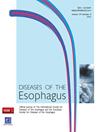242.抑制 brd4 可通过调节 atf3 介导的丝氨酸和核苷酸合成增强食管鳞状细胞癌的放射敏感性
IF 2.3
3区 医学
Q3 GASTROENTEROLOGY & HEPATOLOGY
引用次数: 0
摘要
背景 放射抗性是食管鳞状细胞癌(ESCC)放疗失败的罪魁祸首。本研究旨在探讨Brd4在ESCC放射敏感性中的潜在机制。方法 使用 IHC 评估放射敏感性和放射耐受性 ESCC 组织中的 Brd2/3/4 蛋白。为了验证Brd4在ESCC中的重要性,进行了一系列功能实验。RNA-seq和生物信息学分析用于确定潜在的下游靶标。双荧光素酶报告和 ChIP 检测进一步研究了各靶点之间的潜在调控机制。此外,我们还进一步验证了 ATF3 介导的丝氨酸和核苷酸代谢在辐射 ESCC 细胞中的重要性。结果 Brd4在耐放射ESCC组织中高表达。敲除 Brd4 会导致辐照 ESCC 细胞的 DNA 损伤和细胞凋亡增加。RNA-seq分析表明,ATF3是Brd4的潜在下游靶标。双荧光素酶报告和 ChIP 分析表明,Brd4 通过激活 ATF3 的启动子区域上调 ATF3 的表达。此外,我们还发现 ATF3 可促进参与丝氨酸和核苷酸生物合成途径的酶活性,从而促进辐射诱导的 DNA 损伤修复。结论 Brd4 通过与 ATF3 启动子区域结合并激活 ATF3,从而促进 ATF3 的表达。增强的 ATF3 会进一步提高丝氨酸和核苷酸生物合成途径中关键酶的活性,从而促进辐射诱导的 DNA 损伤修复。靶向 Brd4 是一种很有前景的治疗策略,可提高 ESCC 的放射敏感性。本文章由计算机程序翻译,如有差异,请以英文原文为准。
242. BRD4 INHIBITION ENHANCES THE RADIOSENSITIVITY OF ESOPHAGEAL SQUAMOUS CELL CARCINOMA THROUGH REGULATING ATF3-MEDIATED SERINE AND NUCLEOTIDE SYNTHESIS
Background Radioresistance is a major culprit for radiotherapy failure in esophageal squamous cell carcinoma (ESCC). This study aimed to investigate the underlying mechanism of Brd4 in radiosensitivity of ESCC. Methods Brd2/3/4 proteins were assessed in radiosensitive and radioresistant ESCC tissues using IHC. A serial of functional experiments was performed to verify the significance of Brd4 in ESCC. RNA-seq and bioinformatics analyses were used to determine the potential downstream targets. The dual-luciferase reporter and ChIP assay were further examined the underlying regulatory mechanism among targets. Besides, we further verified the importance of ATF3-mediated serine and nucleotide metabolism in radiated ESCC cells. Results Brd4 is highly expressed in radio-resistant ESCC tissue. Knockdown of Brd4 led to increased DNA damage and cell apoptosis in irradiated ESCC cells. RNA-seq analyses exhibited that ATF3 was a potential downstream target of Brd4. The dual-luciferase reporter and ChIP assay demonstrated that Brd4 upregulated ATF3 expression via activation its promoter region. Besides, we found that ATF3 could facilitate the enzyme activities involved in serine and nucleotide biosynthesis pathway to promote radiation-induced DNA damage repair. Conclusion Brd4 facilitates ATF3 expression via binding to and activating ATF3 promoter region. Enhanced ATF3 further increases crucial enzymes activity in serine and nucleotide biosynthesis pathway to promote radiation-induced DNA damage repair. Targeting Brd4 is a promising treatment strategy to improve radiosensitivity in ESCC.
求助全文
通过发布文献求助,成功后即可免费获取论文全文。
去求助
来源期刊

Diseases of the Esophagus
医学-胃肠肝病学
CiteScore
5.30
自引率
7.70%
发文量
568
审稿时长
6 months
期刊介绍:
Diseases of the Esophagus covers all aspects of the esophagus - etiology, investigation and diagnosis, and both medical and surgical treatment.
 求助内容:
求助内容: 应助结果提醒方式:
应助结果提醒方式:


